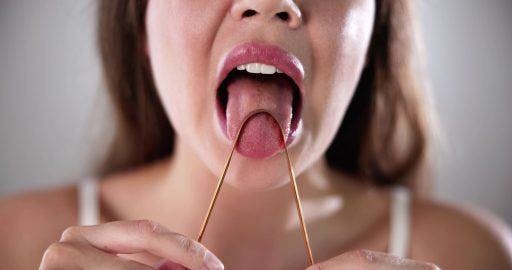A white tongue is usually a harmless condition you can treat at home. But on rare occasions, it can signify serious health issues. That’s why it’s vital to monitor your symptoms and seek treatment accordingly. Here, learn the possible answers next time you face a mirror and ask, “Does a white tongue mean you are sick?”
What Is White Tongue?
White tongue is a condition characterised by a thick, creamy, cottage cheese-like coating. It occurs when the tiny bumps (papillae) lining the tongue become inflamed.
Causes of White Tongue
But what causes them to swell in the first place? The answer is simple: when bacteria, fungi, dirt, food debris, and dead cells get trapped and accumulate on the tongue, papillae enlargement can occur.
The most common white tongue causes include:
- Poor oral hygiene (not brushing, flossing, or scraping your tongue regularly)
- Smoking, chewing on tobacco, or vaping
- Dehydration, especially from consuming too many alcoholic beverages
- Irritation from sharp objects on your teeth or use of dental instruments (dentures)
- Eating an unbalanced diet lacking fruits and vegetables
- Mouth breathing
- Dry mouth
- Yeast infection as a side effect of antibiotic medication
Typically, the white layer on the tongue goes away within weeks. But when it persists, you should be wary of several potential consequences for your oral health.
Should You Worry About White Tongue?

A white velvety surface on the tongue can cause a few unresolved issues. With correct dental hygiene practices, you can avoid the following health concerns:
- Bad breath
- Open sores
- Trouble chewing, swallowing, or talking
- Gum disease
- Fever
- Weight loss
- Skin rash
Health Conditions Linked to White Tongue
In general, white spots on the tongue are easy to treat. But a whitish film that refuses to clear up in weeks indicates any of the following conditions:
- Leukoplakia – a condition that causes white spots or patches inside the cheeks, along the gums, and on the tongue. The oral disorder stems from excessive alcohol consumption, smoking, or tobacco chewing habits. If left unchecked, leukoplakia can lead to oral cancer.
- Oral thrush – a mouth infection due to the presence of candida yeast. It can result in a burning sensation in the mouth, loss of taste, and difficulty eating and drinking. Most individuals with oral thrush have underlying conditions, like diabetes or vitamin B and iron deficiency. Others may have weakened immunities because of HIV or AIDS.
- Oral lichen planus – a chronic inflammation that produces white lacy patches or open sores in the mouth and on the tongue. Besides the visible white coating, the condition can cause gum soreness.
- Syphilis – a sexually transmitted infection that can cause mouth sores. If left untreated, it can lead to white patches on the tongue, similar to leukoplakia.
- Tongue cancer – the most severe cause of white tongue lesions. Although this cancer is rare, certain risk factors, including poor oral hygiene, can increase the likelihood of its development.
How to Prevent White Tongue

Preventive measures to combat the condition overlap neatly with basic hygiene habits. Follow these dental dos and don’ts for that sought-after bright smile matched by a healthy, pink tongue.
Dos:
- Use a soft-bristled toothbrush.
- Opt for fluoride toothpaste.
- Brush teeth at least twice daily.
- Pick a fluoride mouthwash and swish daily.
- Floss at least once a day.
- Clean tongue with a scraper regularly.
- Visit your dentist every six months for a checkup and cleaning.
- Eat a well-balanced diet containing fruits and vegetables.
- Get misaligned teeth fixed (consider ClearCorrect!) to stop hard-to-reach dirt and debris from building up.
Don’ts:
- Use toothpaste containing sodium lauryl sulfate.
- Smoke and use any tobacco products.
- Consume too much alcohol.
- Eat hard, salty, spicy, acidic, or hot foods and beverages in excess.
- Neglect regular visits to your dentist.
- Ignore symptoms that won’t resolve after treatment.
The presence of a coated tongue is more than just unsightly. Underneath the layer of coagulated-looking cheese could either be a harmless or a more serious health condition. So, how to get rid of white tongue? Consult with your oral health provider to determine the underlying cause.
They can assess if factors such as an impacted tooth, overbite, or cavities allow bacteria to thrive and contribute to your white tongue. They can also recommend the most appropriate treatment plan, whether surgery, ClearCorrect invisible aligners, or a simple lifestyle change. Don’t wait! Schedule an appointment with a professional to address your dental issues today.
References:
Institute for Quality and Efficiency in Health Care (IQWiG). (2019, August 15). Oral thrush: Overview. InformedHealth.org – NCBI Bookshelf.
Lavanya, N., Jayanthi, P., Rao, U. K., & Ranganathan, K. (2011). Oral lichen planus: An update on pathogenesis and treatment. Journal of Oral and Maxillofacial Pathology, 15(2), 127.
Oral Cancer Facts – Oral Cancer Foundation | Information and Resources about Oral Head and Neck Cancer. (n.d.).
Parlatescu, I. (2014, March 1). Oral Leukoplakia – an Update. PubMed Central (PMC).
World Health Organization: WHO. (2022). Syphilis — Global. www.who.int.



